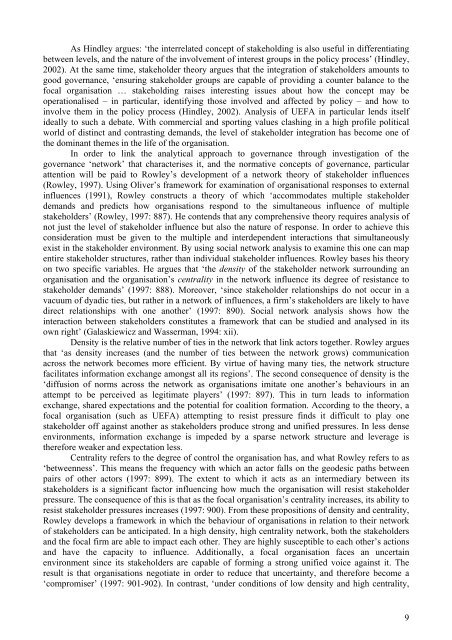UEFA, Governance, and the Control of Club Competition in ...
UEFA, Governance, and the Control of Club Competition in ...
UEFA, Governance, and the Control of Club Competition in ...
You also want an ePaper? Increase the reach of your titles
YUMPU automatically turns print PDFs into web optimized ePapers that Google loves.
As H<strong>in</strong>dley argues: ‘<strong>the</strong> <strong>in</strong>terrelated concept <strong>of</strong> stakehold<strong>in</strong>g is also useful <strong>in</strong> differentiat<strong>in</strong>gbetween levels, <strong>and</strong> <strong>the</strong> nature <strong>of</strong> <strong>the</strong> <strong>in</strong>volvement <strong>of</strong> <strong>in</strong>terest groups <strong>in</strong> <strong>the</strong> policy process’ (H<strong>in</strong>dley,2002). At <strong>the</strong> same time, stakeholder <strong>the</strong>ory argues that <strong>the</strong> <strong>in</strong>tegration <strong>of</strong> stakeholders amounts togood governance, ‘ensur<strong>in</strong>g stakeholder groups are capable <strong>of</strong> provid<strong>in</strong>g a counter balance to <strong>the</strong>focal organisation … stakehold<strong>in</strong>g raises <strong>in</strong>terest<strong>in</strong>g issues about how <strong>the</strong> concept may beoperationalised – <strong>in</strong> particular, identify<strong>in</strong>g those <strong>in</strong>volved <strong>and</strong> affected by policy – <strong>and</strong> how to<strong>in</strong>volve <strong>the</strong>m <strong>in</strong> <strong>the</strong> policy process (H<strong>in</strong>dley, 2002). Analysis <strong>of</strong> <strong>UEFA</strong> <strong>in</strong> particular lends itselfideally to such a debate. With commercial <strong>and</strong> sport<strong>in</strong>g values clash<strong>in</strong>g <strong>in</strong> a high pr<strong>of</strong>ile politicalworld <strong>of</strong> dist<strong>in</strong>ct <strong>and</strong> contrast<strong>in</strong>g dem<strong>and</strong>s, <strong>the</strong> level <strong>of</strong> stakeholder <strong>in</strong>tegration has become one <strong>of</strong><strong>the</strong> dom<strong>in</strong>ant <strong>the</strong>mes <strong>in</strong> <strong>the</strong> life <strong>of</strong> <strong>the</strong> organisation.In order to l<strong>in</strong>k <strong>the</strong> analytical approach to governance through <strong>in</strong>vestigation <strong>of</strong> <strong>the</strong>governance ‘network’ that characterises it, <strong>and</strong> <strong>the</strong> normative concepts <strong>of</strong> governance, particularattention will be paid to Rowley’s development <strong>of</strong> a network <strong>the</strong>ory <strong>of</strong> stakeholder <strong>in</strong>fluences(Rowley, 1997). Us<strong>in</strong>g Oliver’s framework for exam<strong>in</strong>ation <strong>of</strong> organisational responses to external<strong>in</strong>fluences (1991), Rowley constructs a <strong>the</strong>ory <strong>of</strong> which ‘accommodates multiple stakeholderdem<strong>and</strong>s <strong>and</strong> predicts how organisations respond to <strong>the</strong> simultaneous <strong>in</strong>fluence <strong>of</strong> multiplestakeholders’ (Rowley, 1997: 887). He contends that any comprehensive <strong>the</strong>ory requires analysis <strong>of</strong>not just <strong>the</strong> level <strong>of</strong> stakeholder <strong>in</strong>fluence but also <strong>the</strong> nature <strong>of</strong> response. In order to achieve thisconsideration must be given to <strong>the</strong> multiple <strong>and</strong> <strong>in</strong>terdependent <strong>in</strong>teractions that simultaneouslyexist <strong>in</strong> <strong>the</strong> stakeholder environment. By us<strong>in</strong>g social network analysis to exam<strong>in</strong>e this one can mapentire stakeholder structures, ra<strong>the</strong>r than <strong>in</strong>dividual stakeholder <strong>in</strong>fluences. Rowley bases his <strong>the</strong>oryon two specific variables. He argues that ‘<strong>the</strong> density <strong>of</strong> <strong>the</strong> stakeholder network surround<strong>in</strong>g anorganisation <strong>and</strong> <strong>the</strong> organisation’s centrality <strong>in</strong> <strong>the</strong> network <strong>in</strong>fluence its degree <strong>of</strong> resistance tostakeholder dem<strong>and</strong>s’ (1997: 888). Moreover, ‘s<strong>in</strong>ce stakeholder relationships do not occur <strong>in</strong> avacuum <strong>of</strong> dyadic ties, but ra<strong>the</strong>r <strong>in</strong> a network <strong>of</strong> <strong>in</strong>fluences, a firm’s stakeholders are likely to havedirect relationships with one ano<strong>the</strong>r’ (1997: 890). Social network analysis shows how <strong>the</strong><strong>in</strong>teraction between stakeholders constitutes a framework that can be studied <strong>and</strong> analysed <strong>in</strong> itsown right’ (Galaskiewicz <strong>and</strong> Wasserman, 1994: xii).Density is <strong>the</strong> relative number <strong>of</strong> ties <strong>in</strong> <strong>the</strong> network that l<strong>in</strong>k actors toge<strong>the</strong>r. Rowley arguesthat ‘as density <strong>in</strong>creases (<strong>and</strong> <strong>the</strong> number <strong>of</strong> ties between <strong>the</strong> network grows) communicationacross <strong>the</strong> network becomes more efficient. By virtue <strong>of</strong> hav<strong>in</strong>g many ties, <strong>the</strong> network structurefacilitates <strong>in</strong>formation exchange amongst all its regions’. The second consequence <strong>of</strong> density is <strong>the</strong>‘diffusion <strong>of</strong> norms across <strong>the</strong> network as organisations imitate one ano<strong>the</strong>r’s behaviours <strong>in</strong> anattempt to be perceived as legitimate players’ (1997: 897). This <strong>in</strong> turn leads to <strong>in</strong>formationexchange, shared expectations <strong>and</strong> <strong>the</strong> potential for coalition formation. Accord<strong>in</strong>g to <strong>the</strong> <strong>the</strong>ory, afocal organisation (such as <strong>UEFA</strong>) attempt<strong>in</strong>g to resist pressure f<strong>in</strong>ds it difficult to play onestakeholder <strong>of</strong>f aga<strong>in</strong>st ano<strong>the</strong>r as stakeholders produce strong <strong>and</strong> unified pressures. In less denseenvironments, <strong>in</strong>formation exchange is impeded by a sparse network structure <strong>and</strong> leverage is<strong>the</strong>refore weaker <strong>and</strong> expectation less.Centrality refers to <strong>the</strong> degree <strong>of</strong> control <strong>the</strong> organisation has, <strong>and</strong> what Rowley refers to as‘betweenness’. This means <strong>the</strong> frequency with which an actor falls on <strong>the</strong> geodesic paths betweenpairs <strong>of</strong> o<strong>the</strong>r actors (1997: 899). The extent to which it acts as an <strong>in</strong>termediary between itsstakeholders is a significant factor <strong>in</strong>fluenc<strong>in</strong>g how much <strong>the</strong> organisation will resist stakeholderpressure. The consequence <strong>of</strong> this is that as <strong>the</strong> focal organisation’s centrality <strong>in</strong>creases, its ability toresist stakeholder pressures <strong>in</strong>creases (1997: 900). From <strong>the</strong>se propositions <strong>of</strong> density <strong>and</strong> centrality,Rowley develops a framework <strong>in</strong> which <strong>the</strong> behaviour <strong>of</strong> organisations <strong>in</strong> relation to <strong>the</strong>ir network<strong>of</strong> stakeholders can be anticipated. In a high density, high centrality network, both <strong>the</strong> stakeholders<strong>and</strong> <strong>the</strong> focal firm are able to impact each o<strong>the</strong>r. They are highly susceptible to each o<strong>the</strong>r’s actions<strong>and</strong> have <strong>the</strong> capacity to <strong>in</strong>fluence. Additionally, a focal organisation faces an uncerta<strong>in</strong>environment s<strong>in</strong>ce its stakeholders are capable <strong>of</strong> form<strong>in</strong>g a strong unified voice aga<strong>in</strong>st it. Theresult is that organisations negotiate <strong>in</strong> order to reduce that uncerta<strong>in</strong>ty, <strong>and</strong> <strong>the</strong>refore become a‘compromiser’ (1997: 901-902). In contrast, ‘under conditions <strong>of</strong> low density <strong>and</strong> high centrality,9




